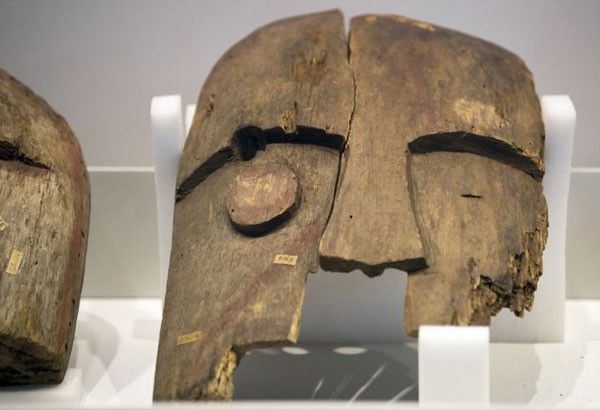German museum returns looted art to indigenous Alaskans

BERLIN — A Berlin museum has returned ancient wooden masks, an idol and other spiritually significant artifacts plundered from graves by an explorer to indigenous Alaskans, ending an odyssey in which many of the items were thought forever lost.
The masks, carved from spruce or hemlock, are daubed with red pigment — a traditional tincture made of seal oil, human blood and powder from a stone that indicate they were used in burial ceremonies by tribes in the Chugach area of Alaska.
One mask comes to a sharp point at the top, symbolizing the deceased's transition to the spirit world. Another shows a face with one eye open and the other closed.
Their exact age hasn't been determined, but they're thought to be up to 1,000 years old. They were taken from graves in caves on Chenega Island in Alaska's Prince William Sound and a place known as Sanradna, whose exact location is no longer known, said John Johnson, a representative of the Chugach Alaska Corporation. The group today represents the region's indigenous people.
"They're a connection between the dead and the living, the future and the past," he said yesterday. "If you look, one eye open, one eye shut, it's like traveling between two worlds."
The nine artifacts were among some 200 Chugach items collected for Germany's Royal Museum of Ethnology by Norwegian adventurer Johan Adrian Jacobsen between 1882 and 1884.
Several were thought lost at the end of World War II after being looted from the museum by Soviet Red Army troops, but they resurfaced in St. Petersburg, Russia. They were then given to a museum in Leipzig in communist East Germany in the 1970s.
Berlin's Ethnological Museum only learned in the 1980s that they had survived and eventually secured their return.
Johnson learned of their existence from Jacobsen's journals, where the explorer detailed how he had found them in caves and taken them. He traced them to the Ethnological Museum.
He led a delegation to Berlin in 2015 and has been working since then with the museum and the Prussian Cultural Heritage Foundation, which oversees Berlin's museums, to establish their provenance and organize restitution.
Other items collected by Jacobsen were determined to have been fairly obtained through purchase or trade.
Elsewhere, Denmark has already returned human remains that were taken from the Chugach area. Johnson said much work remains researching the provenance of other artifacts scattered in museums around the US and the world, including Britain, Russia and Finland.
"Sometimes museums feel that this is the end, that it's a sad day, but this is really a new beginning," he said. "The more you work together, the more you understand and enjoy the significance of these artifacts."
Prussian Cultural Heritage Foundation President Hermann Parzinger carefully handed one of the masks to Johnson at a ceremony yesterday, saying he hoped they could work together on future historical and cultural projects.
Work is underway on an exhibition on Jacobsen, who brought thousands of items to Germany from settlements on the northwest coast of Canada and Alaska. It will offer what Parzinger said will be a "critical examination of the history of the collection from today's perspective."
The self-proclaimed captain's accounts are more adventure than anthropological, Parzinger said.
"Johan Adrian Jacobsen was no academic, he was a sailor," he said.
Ideally the artifacts returned yesterday would go back into the caves from which they were taken, Johnson said, but since that's impossible to do without risking their destruction, the hope is that they will be put on public display in a regional museum.
"They say a picture's worth 1,000 words, but when you have the object it could be a million," he said. "You learn so much when you see them up close."
- Latest
- Trending




























